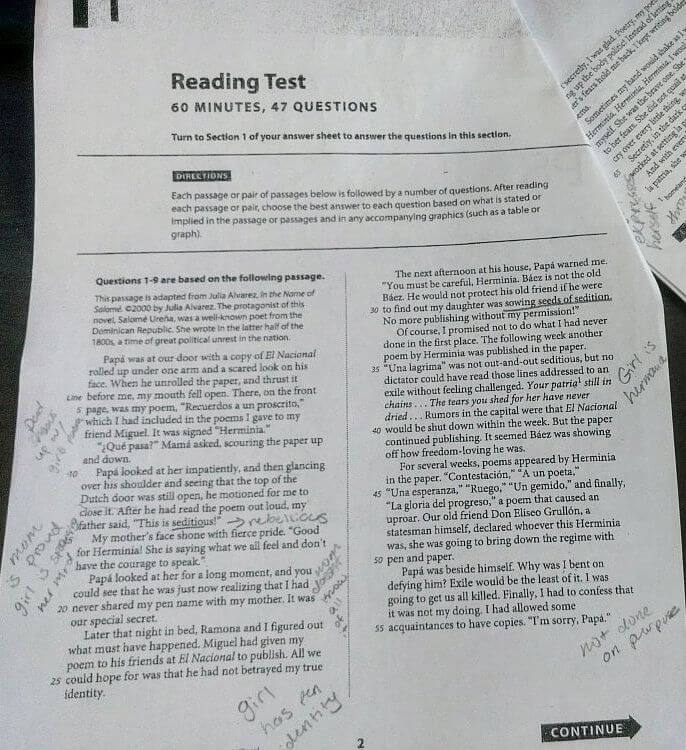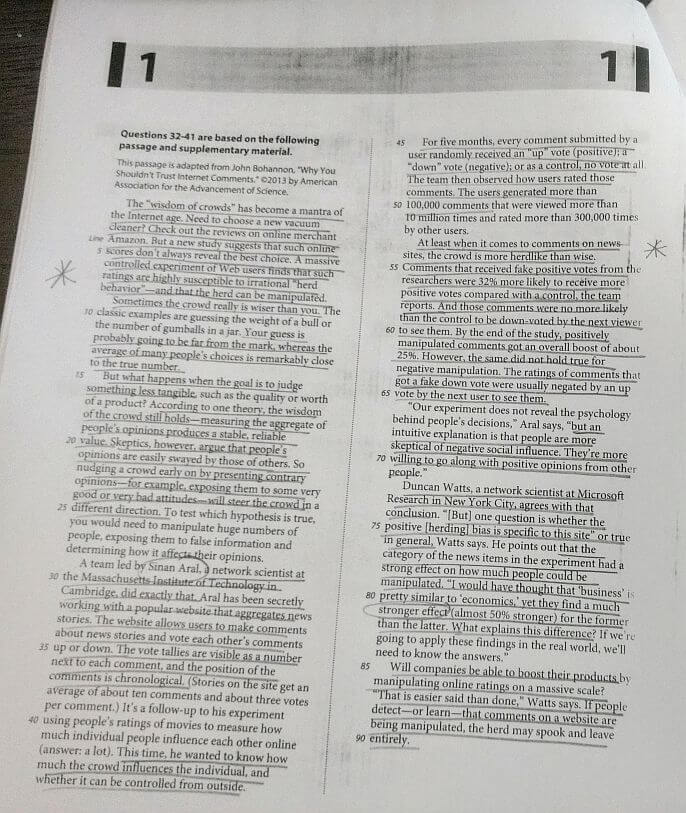Today’s blog post kicks off a 3-part series that contains the secret to success on the SAT. That may overstate it a bit, but make no mistake, students who take this approach to the SAT uniformly do much better on the test. Today we will be focusing on the SAT reading test.
So what’s the secret to the score of your dreams on the SAT? Let’s get right to it: you need to be an active test-taker.
What does it mean to be an active test-taker? We’ll get into what that means for the SAT writing and math sections in future blog posts, but for now we’ll focus on active reading comprehension on the SAT.


I’ve tutored the SAT for eight years now, and in that time I’ve seen students take many different approaches to the test. I’ve watched hundreds of students working their way through SAT questions and practice passages. There have been good strategies, bad strategies, and no strategies at all.
Here is the worst way students approach reading comprehension on the SAT: passively. With their hands in their lap and pencil on the table, leaning back in their chair, letting their eyes drift over the reading passage. After a few minutes, they look up and say “I’m done!” And when I ask them what the passage was all about, most of these students have a hard time accurately summarizing the main argument.
Our SAT tutors help students learn to conquer tough SAT reading comprehension passages by changing their approach. The best SAT reading comprehension strategy is simple and straightforward: read actively, not passively. Let’s talk about what it means to read actively.
The Five Fundamental Steps of Active Reading
- Posture (and attitude) matter. Don’t discount the importance of sitting up in your chair, pencil in hand, and with some tension present. While being too nervous can hinder your performance, some nerves are helpful to keep you alert and focused. If you make it a habit to read every SAT reading comprehension passage with pencil in hand, you’ll be more likely to engage with the passage and take notes. Which brings us to step 2…
- Take notes while you’re reading the passage. This is the piece of advice students least want to hear—it’s rare to find a student who voluntarily takes notes while reading. However, this is probably the single most important recommendation in the list. Note-taking while you’re reading serves several purposes: it helps you find answers more quickly when you return to the passage; it helps you actively process the author’s arguments; and it helps you stay focused better than just reading does. So what should these notes look like?
- Write a brief summary of each paragraph in the margin. What should your notes not look like? Every line of a paragraph shouldn’t be underlined, and there should be actual words written down in the margins. Underlining, circling, and starring has its place in note-taking, but the point of taking notes on SAT reading passages is to process actively. When you know that you have to briefly summarize each paragraph, you’ll have an easier time focusing on what you’re reading and thinking about its purpose in the context of the passage. Just underlining everything may help your eyes follow along with the words, but it doesn’t help you make sense of what you’ve read.
- Write down the author’s main argument once you’re done reading. Don’t head straight for the questions! Take 30 seconds to process what you’ve just read and decide what the author’s overall argument is. Are they for or against an issue? What kind of evidence did they use? Do they agree or disagree with most other people in their field? Many SAT reading comprehension questions will ask you about the significance of a section of the passage in the context of the main argument of the entire passage. If you don’t know the main argument, you’re at a major disadvantage. Remember, don’t let yourself off the hook—actually write the main argument down on the page. It’s the only way to make sure you really understand the passage!
- Practice active reading on the SAT reading comprehension questions as well. Active reading strategies aren’t just for reading the passage itself. SAT reading questions can be tricky. Make sure you take the time to read each question carefully. Circle or underline important words or line references, and take the time to refer back to the passage. Work through the answer choices methodically, eliminating wrong answers as you go. Read the answer choices actively and carefully too—sometimes an answer will look tempting, but one word in the answer is wrong and disqualifies it. The correct answer will answer the question being asked and be factually correct.
Still having trouble with SAT reading comprehension? Try these bonus tips:
- Make a movie of the passage in your head. Stay with me here—I know this sounds cheesy and irrelevant. However, research has shown that the ability to visualize what you’re reading is a strong predictor of reading comprehension success. So if you’re having a hard time focusing on a passage or understanding it, pretend you’re turning it into a movie and you’re the director. What does it look like visually? How do the actors relate to each other? What’s the body language and the unspoken subtext? You’re reading one of those dry passages from the 1800s—now imagine Frederick Douglass standing at a podium on a hot summer day, thundering down judgment on a crowd of people ready to congratulate themselves for being on the right side of the slavery controversy. Imagine them exchanging shocked glances, faces burning with embarrassment. All of a sudden, the passage comes alive and you, the reader, get it on a much deeper level.
- Know yourself. Most students have passages they like and passages they don’t like. This varies from student to student. Some enjoy the Frederick Douglass passage mentioned above (that’s me!), while others would read passages about astrophysics and varieties of oak trees all day long (definitely not me). Self-knowledge is an important component of success on SAT reading comprehension. Because I know that I struggle to focus on science passages, I hold myself to a higher standard on those passages. I diligently summarize each paragraph and write down the overall main argument—no exceptions—even though I’d rather skip over science passages entirely. Be honest with yourself and identify the types of passages you struggle with. Then, double down on those passages on test day.
SAT reading comprehension is tough for everyone. Sixty-five minutes straight of reading challenging passages and answering complex questions is a test of not just your reading ability, but also your ability to focus on a task for a long period of time. Learning to be an active reader on the SAT isn’t a magic pill for score improvement. However, practiced consistently, active reading will considerably improve your confidence on SAT reading comprehension—and ultimately your score as well.

